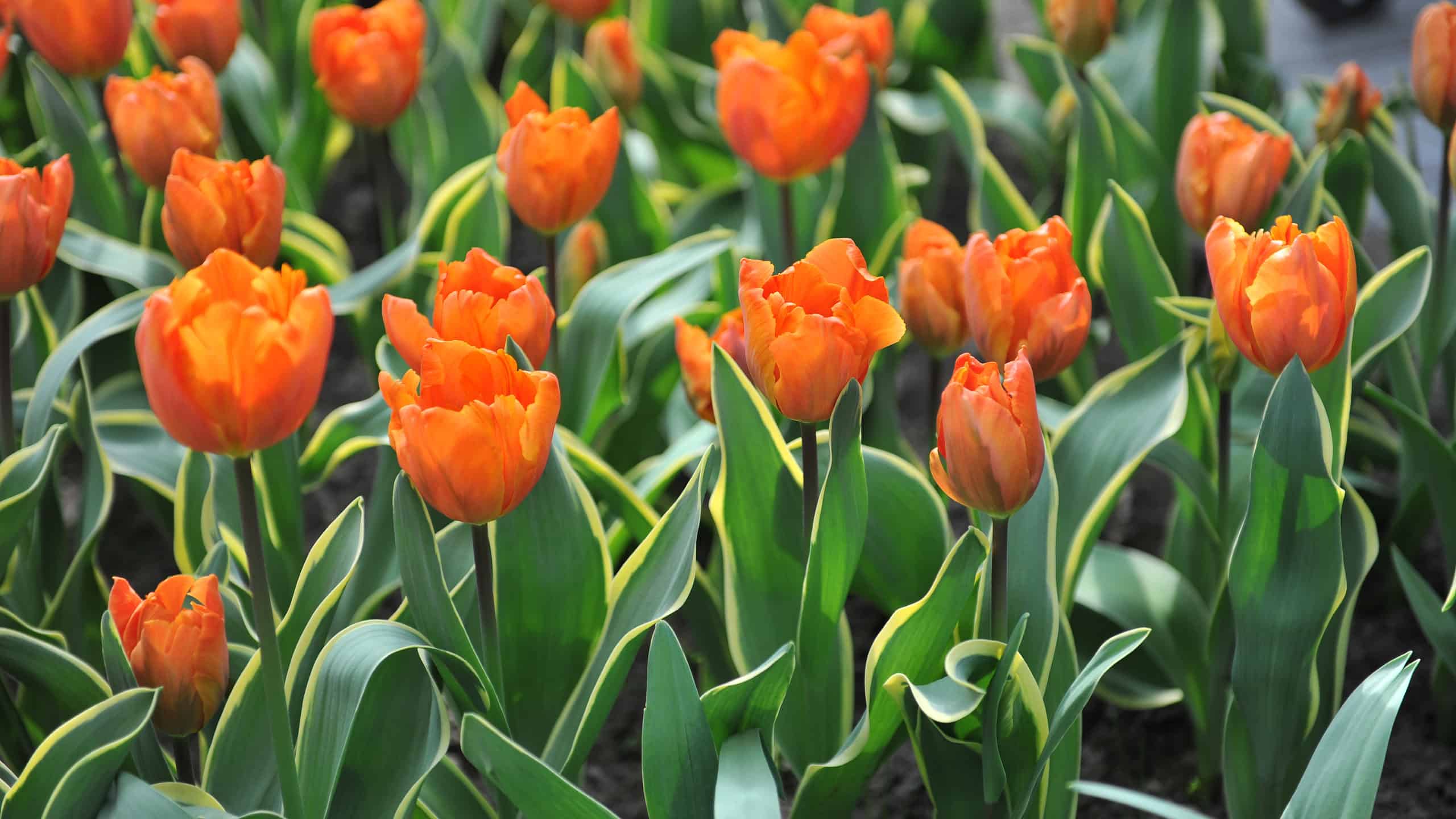There’s something about orange tulips scattered throughout a flower garden. Each one catches the sunlight in a unique way, setting the world ablaze with its beauty.
In addition, there is a wide variety of tulip species, comprising over 3,000 cultivars, each available in a plethora of shades, offering an extensive range of options to choose from.
Here are 16 eye-catching orange tulips to breathe life into your garden this season.
The History of Orange Tulips
While most flowers have a unique history, rich symbolism, and cultural significance, the tulip stands apart. The most notable highlight in tulip history was Tulipmania — a near-fanatical period when tulips were the most desired and popular bloom.
However, orange tulips have a history of their own. These bright blooms are a symbol of understanding and appreciation. In 1945, after WWII ended, the Dutch Royal family sent hundreds of thousands of orange tulip bulbs to Canada in appreciation of wartime efforts to liberate Holland.
In 2020, Canada celebrated Liberation75 for the 75th anniversary of the liberation. During this event, Canadians were encouraged to purchase orange tulip bulbs, with proceeds going toward the Royal Canadian Legion.
Canadians purchased and planted 1.1 million bulbs, including 100,000 from the Dutch Royal Family in tribute to their gift 75 years earlier. In 2020, orange tulip blooms swept the nation and capitol — unfortunately, most people could not see them due to the pandemic.
Orange tulips are also prevalent in Canadian remembrance gardens to pay tribute to loved ones who have died.
With this intriguing history in mind, here are some top breeds of orange tulips.
Je t’Aime

The rare
Tulipa‘Je t’Aime’ is similar in appearance to the Elegant Lady, with notes of orange rather than pink.
©Sergey V Kalyakin/Shutterstock.com
Botanical Name: Tulipa ‘Je t’Aime’
French for “I love you,” Je t’Aime tulips are a warm orange tone with yellow accents. Their unique shape boasts compact petals that fountain outward at the top for a fluted appearance. Blue-green leaves contrast the bright blooms with eye-catching scalloped edges.
This bright orange bloom is surprisingly difficult to find, yet one of the more popular orange tulip varieties. They grow in well-draining soil and full sunlight in USDA hardiness zones 3-9.
Tulipa ‘Je t’Aime’ is a mid to late-season bloomer. It grows 14-16 inches tall with a spread of up to 5 inches. While deadheading is advised for overwintering, it’s integral to wait until the bloom and foliage die away completely so nutrients are redirected to the bulb.
Disneyland Paris

a
‘Disneyland Paris’ is a bold, orange tulip that almost looks animated.
©serdar_basak/Shutterstock.com
Botanical name: Tulipa ‘Disneyland Paris’
Another exciting tale in the history of orange tulips is the dedication to Disneyland Paris. The Netherlands gifted this cultivar to the theme park in honor of its 20th anniversary.
The Disneyland Paris is a Double Orange Emperor cultivar with thick, luscious, vibrant orange petals. The color is so bright that it looks as though it could have been plucked from one of the animated fairytales that brought the Disney name so much fame.
Disneyland Paris requires full sunlight and grows 18-20 inches tall. It’s an early bloomer that grows in USDA zones 3-8.
Charming Beauty
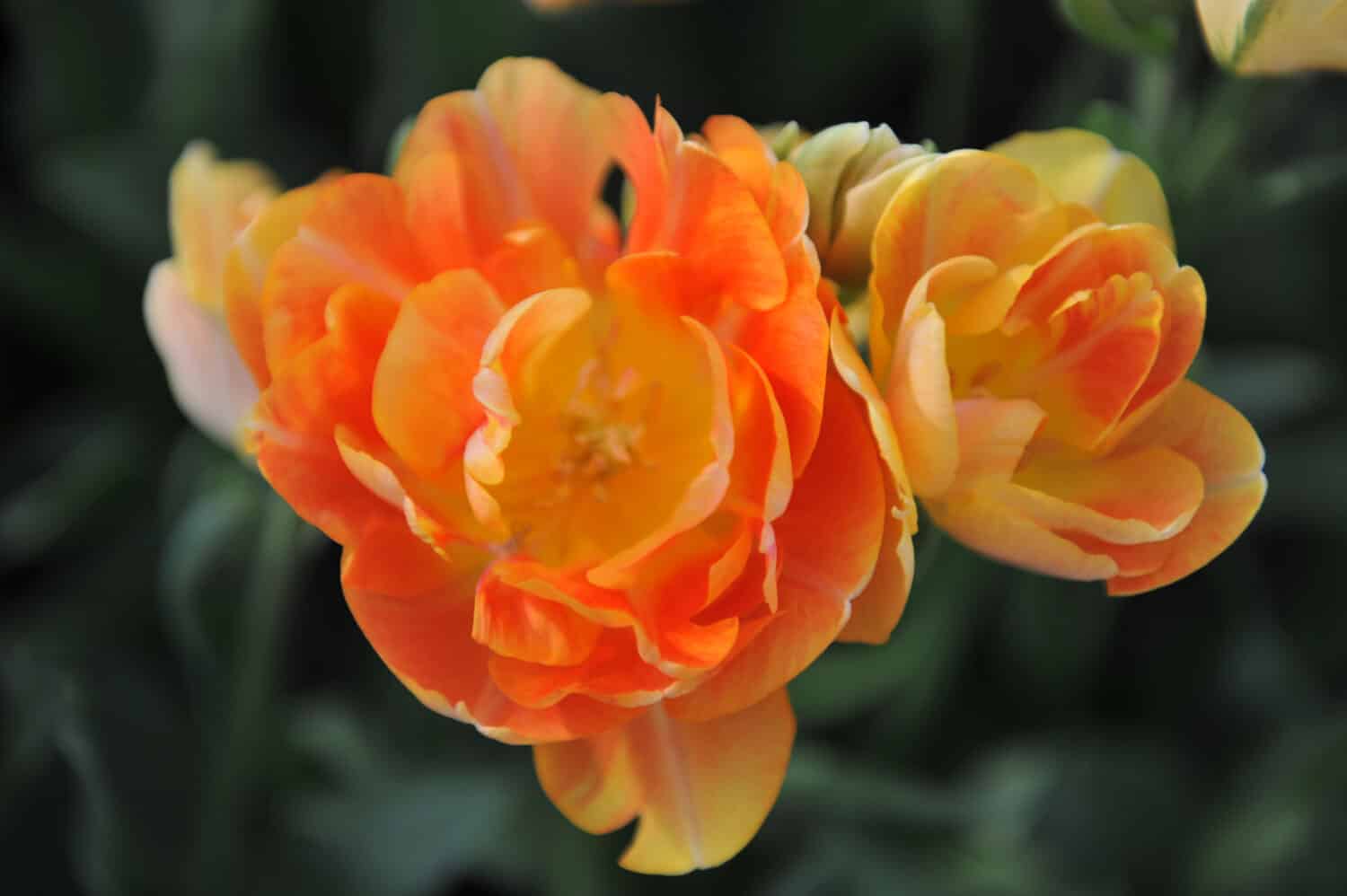
‘Charming Beauty’ is the perfect tulip for peony lovers.
©Sergey V Kalyakin/Shutterstock.com
Botanical Name: Tulipa ‘Charming Beauty‘
Aptly named, the Charming Beauty is an enchanting double late tulip with peachy-orange and yellow petals. As the season progresses, the peach tones deepen into a rich, vibrant orange.
This orange bloom looks more like a peony than a tulip, making it perfect for those who enjoy the delicate, luxe look peonies are known for.
Tulipa ‘Charming Beauty’ grows up to 24 inches tall and 4-5 inches wide. Its deep green foliage complements and contrasts the stunning orange blooms.
Plant this tulip in full sunlight and well-draining soil in USDA hardiness zones 3-8.
Orange Emperor

Orange Emperor Tulips have a soft yellow center with contrasting black anthers.
©Andrew Fletcher/Shutterstock.com
Botanical Name: Tulipa ‘Orange Emperor’
The Orange Emperor is one of the best-known tulip species. It’s a Fosteriana tulip named for its large flowers. The bright orange petals lighten to a soft yellow toward the bloom’s center, punctuated by contrasting black anthers. The pale green shade often extends upward from the stem, leaving a shadow of its presence on the bottom of the bloom.
These early bloomers grow up to 16 inches tall and can reach up to 10 inches wide in full bloom under ideal conditions. However, you can expect flowers at least five inches wide.
This sun-loving orange tulip requires South or East-facing placement and well-draining soil. It will grow in USDA zones 3-8.
Little Princess

Tulipa ‘Little Princess’ is a dwarf tulip variety.
©Thijs de Graaf/Shutterstock.com
Botanical Name: Tulipa’ Little Princess’
This orange tulip is a dwarf variety, reaching only 4-6 inches in height and no more than three inches wide. However, its small stature doesn’t take away from its eye-catching appearance.
The petals are pointed, blooming in shades of rustic orange and gold (though sometimes they look more red than orange). The center of the Little Princess is yellow and black to attract pollinators.
The Little Princess is a mid-season bloomer. It requires full sun to thrive and can grow in planters with adequate drainage and depth. The Little Princess is great at naturalizing and spreading, making it a low-maintenance addition to the border of your walkways and gardens. Plant this tulip in USDA zones 4-8.
Tulipa whittallii
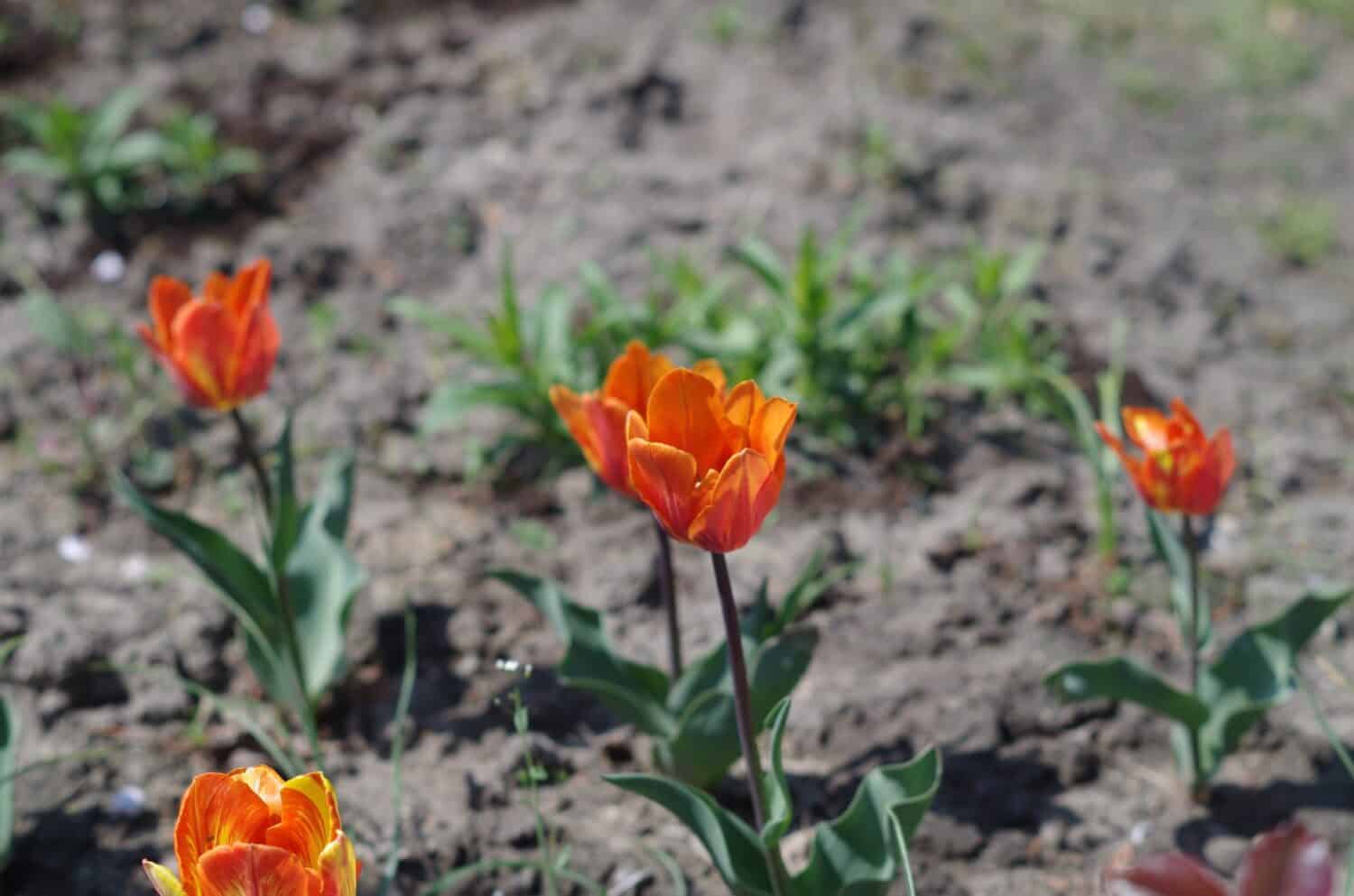
‘Whittallii Group’ is a species of
Tulipa orphanidea, pictured here.
©shadesofquartz/Shutterstock.com
Botanical Name: Tulipa orphanidea ‘Whittallii Group’ syn. Tulipa whittallii
Tulipa orphanidea is a species of botanical tulip that’s been cultivated many times. Its taxonomy is considered complex and fluid due to how it’s been hybridized and cultivated over the years.
The Tulipa orphanidea ‘Whittallii Group’ is recognizable by its copper-orange, pointed petals with notes of green on the tips. The center is a deep green-black tone that contrasts with the surrounding orange. A known naturalizer, this cultivar dates back to 1929.
Tulipa whittallii grows up to 12 inches tall and 4 inches wide and prefers full sun or partial shade to grow. Plant in well-draining soil in USDA zones 4-8.
Annie Schilder
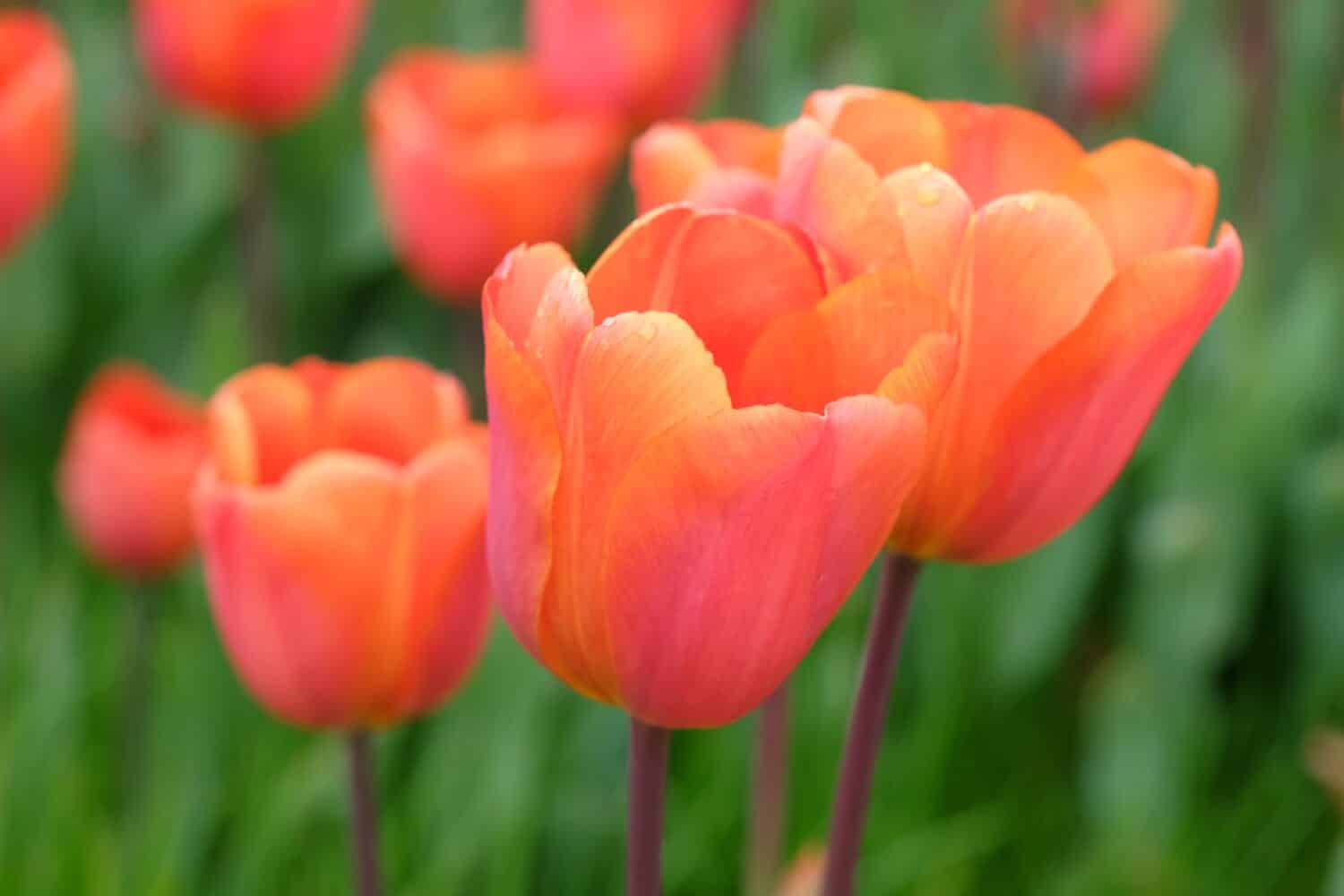
‘Annie Schilder’ has soft tones of pink and looks red in some light.
©Alex Manders/Shutterstock.com
Botanical Name: Tulipa ‘Annie Schilder’
Annie Schilder isn’t the first tulip named after someone, but it’s one of the most well-known. Named after a Dutch actress and musician, this cultivar was only registered in 1982. The tulip is a stunning shade of coral with pink undertones that almost make the flower look red in some light.
This fragrant tulip is a mid to late-season bloomer that grows up to 16 inches with a spread of 6-9 inches in full bloom. This Triumph tulip grows in USDA zones 3-8 and prefers full sun and well-draining soil.
Apricot Impression
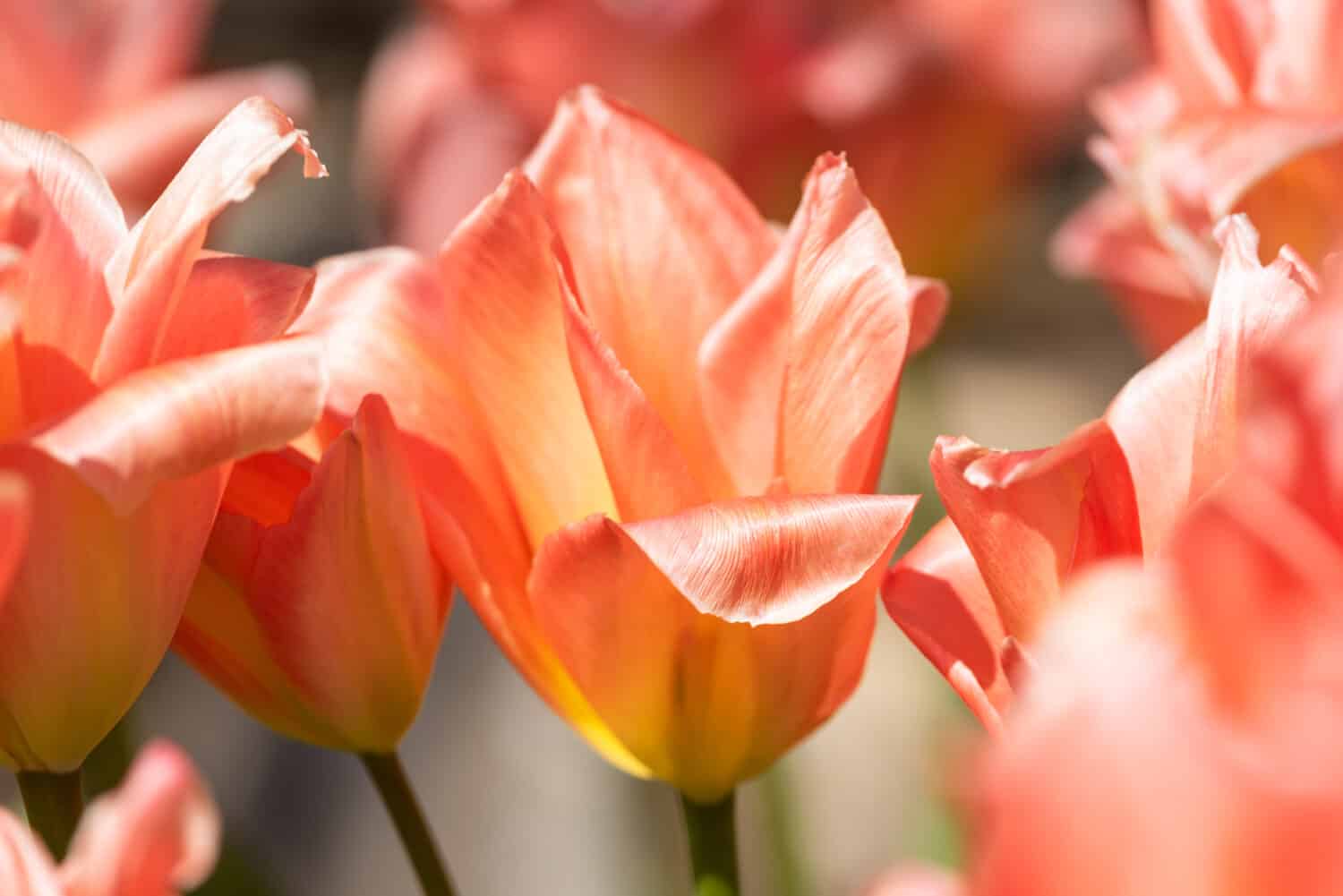
Apricot Impression has soft peach and pink undertones.
©Andrew Fletcher/Shutterstock.com
Botanical Name: Tulipa ‘Apricot Impression’
The Apricot Impression tulip is a Darwin hybrid created from single late tulips and early Emperor tulips. The result is a stunning, vibrant single tulip that blooms in the mid to late spring.
Apricot Impression has a bold coral tone that sometimes has soft peach or pink undertones or deepens to an apricot shade. Each soft and velvety petal creates a sense of luxuriousness and sophistication that’s smooth to the touch. This large species grows up to 24 inches tall with a 4-inch spread.
Plant this variety in full sunlight with well-draining soil in USDA zones 3-8. If you live in an area with harsh winters, add mulch over the tulip bed to protect the bulbs.
Ballerina

‘Ballerina’ is a lily-flowered tulip.
©Alex Manders/Shutterstock.com
Botanical Name: Tulipa ‘Ballerina’
The Ballerina tulip is a true orange. This species is also called a lily-flowered tulip due to its similarities to tiger lilies. The petals have delicate ruffles, creating a sense of movement and texture that makes them alluring. The tips of each petal are tinged with a warm, sunny yellow that blends seamlessly into the orange, creating a stunning ombre effect that feels both bold and subtle at the same time.
The Ballerina grows up to 24 inches tall with a spread of 3-5 inches. It’s a late-season bloomer with a bold fragrance that deters pests and attracts pollinators.
These gorgeous tulips are easy to grow, requiring full sun and well-draining soil. Place these beauties in a wind-protected garden, as the long stems are susceptible to strong gusts. Ballerina tulips grow in USDA zones 3-8.
Princess Irene

Tulip Princess Irene, a delightful color combination of orange with purple flames.
©iStock.com/ValerijaP
Botanical Name: Tulipa ‘Princess Irene’
Princess Irene tulips are one of the most prized and treasured species. Recognized by its delicate, satin-like petals, painted with vibrant shades of orange, yellow, and scarlet that blend in a captivating dance of colors. This otherworldly tulip practically glows in the sun.
Tulipa ‘Princess Irene’ has a wide growth range, from 12-14 inches tall and a spread of 3-5 inches. These triumph tulips are mid to late-season bloomers.
Plant your Princess Irene tulips in well-draining soil in a space with full sunlight. These tulips are ideal for USDA zones 3-8.
Willem van Oranje
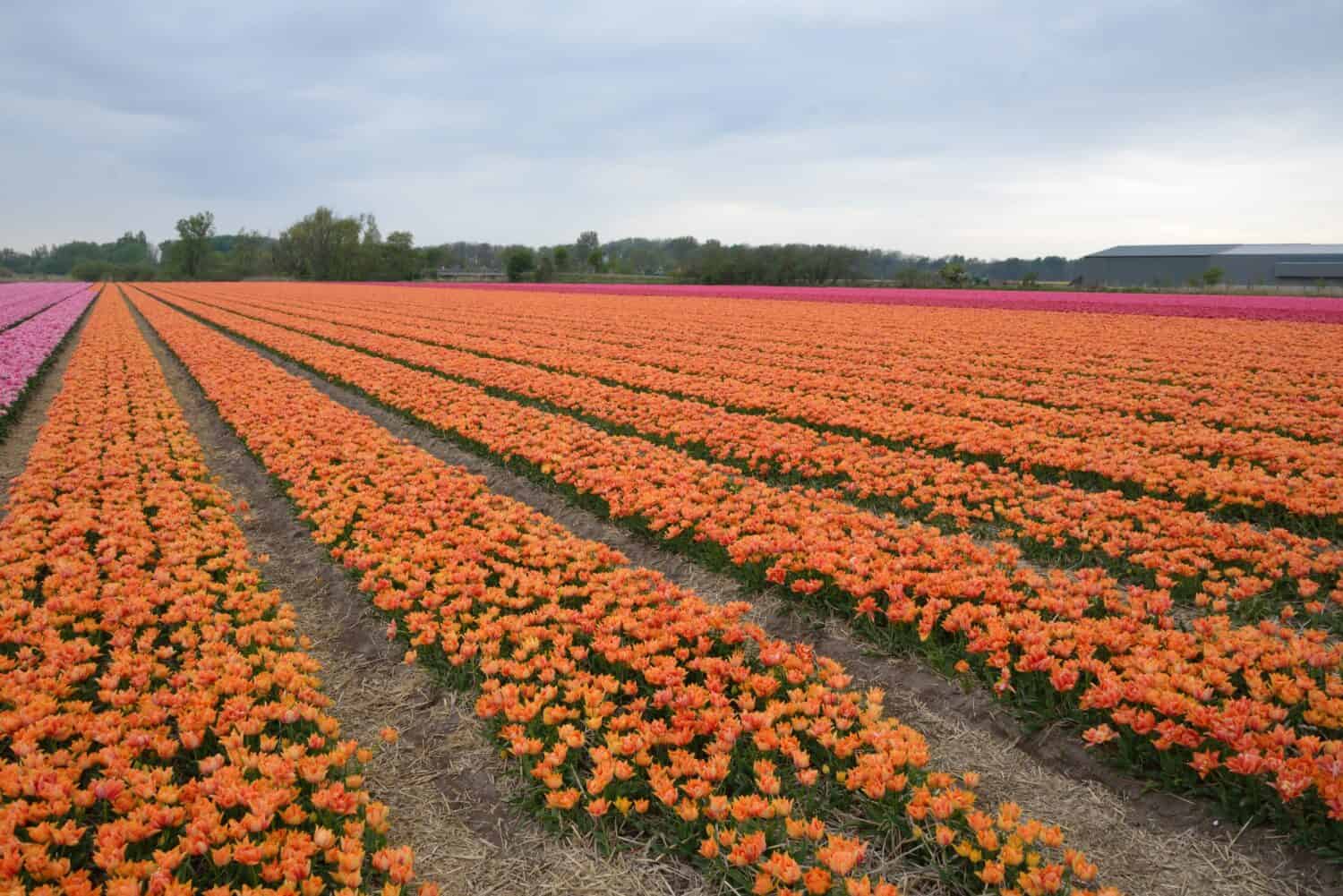
‘Willem van Oranje’ is also known as Prince of Orange.
©Walter Erhardt/Shutterstock.com
Botanical Name: Tulipa ‘Willem van Oranje’
Willem van Oranje is a sight to behold. Its double-layered petals are elegantly arranged in a cup-like shape. The petals are a fiery shade of bright orange, with a slight hint of red at the base, giving the flower a vibrant and eye-catching appearance.
The outer layer of petals is broad and slightly rounded, while the inner layer is smaller and more intricately shaped, with frilled edges that add a delicate touch to the overall appearance.
This tulip is named for Dutch revolutionary Willem van Oranje (William of Orange), who led the Dutch revolt against the Spanish and helped achieve independence in the 1600s.
This double tulip blooms in early to mid-spring in USDA zones 3-8. It grows up to 12 inches tall on stalk-like stems to support its large, showy blooms in a 3-5 inch spread. Plant Willem van Oranje in full sunlight with well-draining soil.
Daydream

The Daydream tulip looks similar to ice cream.
©Liviu Gherman/Shutterstock.com
Botanical Name: Tulipa ‘Daydream’
Another Darwin hybrid, the Daydream is reminiscent of a creamsicle in tone. The base color of the petals is creamy ivory, which gradually blends into soft orange and deep saffron tones towards the edges of the petals. This long-lasting tulip species changes color as the season progresses, getting bolder and more eye-catching every day.
The Daydream tulip grows up to 20 inches tall with a 4-inch spread. Its slender stem is susceptible to wind. However, this tulip is more tolerant of partial shade than some of its relatives.
Plant this lovely tulip in a sheltered area with well-draining soil in USDA zones 3-8.
Orange Princess Tulip

The Orange Princess is similar in appearance to Princess Irene, except with beautiful
double blooms
.
©Tatiana Alex/Shutterstock.com
Botanical Name: Tulipa ‘Orange Princess’
The orange princess is similar in color to Princess Irene but with a lush, full double bloom. This double late tulip is a gorgeous flower with a truly regal appearance.
The frilly, yellow-orange stamens densely pack the center of the bloom, adding a burst of contrasting color and texture. With proper care, this tulip will grow 18-22 inches tall with a spread of 3-4 inches when in full bloom.
Orange Princess does well in full sunlight in well-draining soil. Plant in USDA zones 3-8 for optimal results.
Orange Toronto

Bright orange-red Toronto Tulips with fully open blooms.
©Andrianova Tanya/Shutterstock.com
Botanical Name: Tulipa ‘Orange Toronto’
The Orange Toronto is named after the city of Toronto, which is located in Ontario, Canada. This tulip is particularly striking, with vibrant, elongated orange petals that seem to radiate warmth and energy. The tulip’s bold coloration is a fitting tribute to both the beauty of the tulip and the vibrant energy of the city it’s named after.
Orange Toronto is a Greigii tulip, a hybrid recognized by its shorter stature and petal separation. Toronto grows no more than 12 inches tall with a spread of up to four inches. This tulip prefers full sun and well-draining soil in USDA zones 3-8. The Orange Toronto also prefers areas with cold winters and warm summers — perfect for its Canadian namesake!
Orange Favorite

The Orange Favorite Tulip has slightly ruffled petals.
©Blomsterflickan/Shutterstock.com
Botanical Name: Tulipa ‘Orange Favorite’
The Orange Favorite Tulip is a delightful and striking tulip that will add a pop of color to any garden or floral arrangement. Its bright orange petals are beautifully shaped and have a soft, velvety texture. The stems of the plant are strong and sturdy, easily supporting the blooms.
The Orange Favorite is known for its excellent resistance to disease and pests, making it a low-maintenance and reliable choice for any gardener. This flower has a long vase life, making it perfect for bouquets and arrangements.
This fan-favorite tulip grows up to 16 inches tall with a large spread. It can survive in USDA zones 3-8 but fares better in zones 4-6. Plant in full sunlight with well-draining soil.
Orange Brilliant
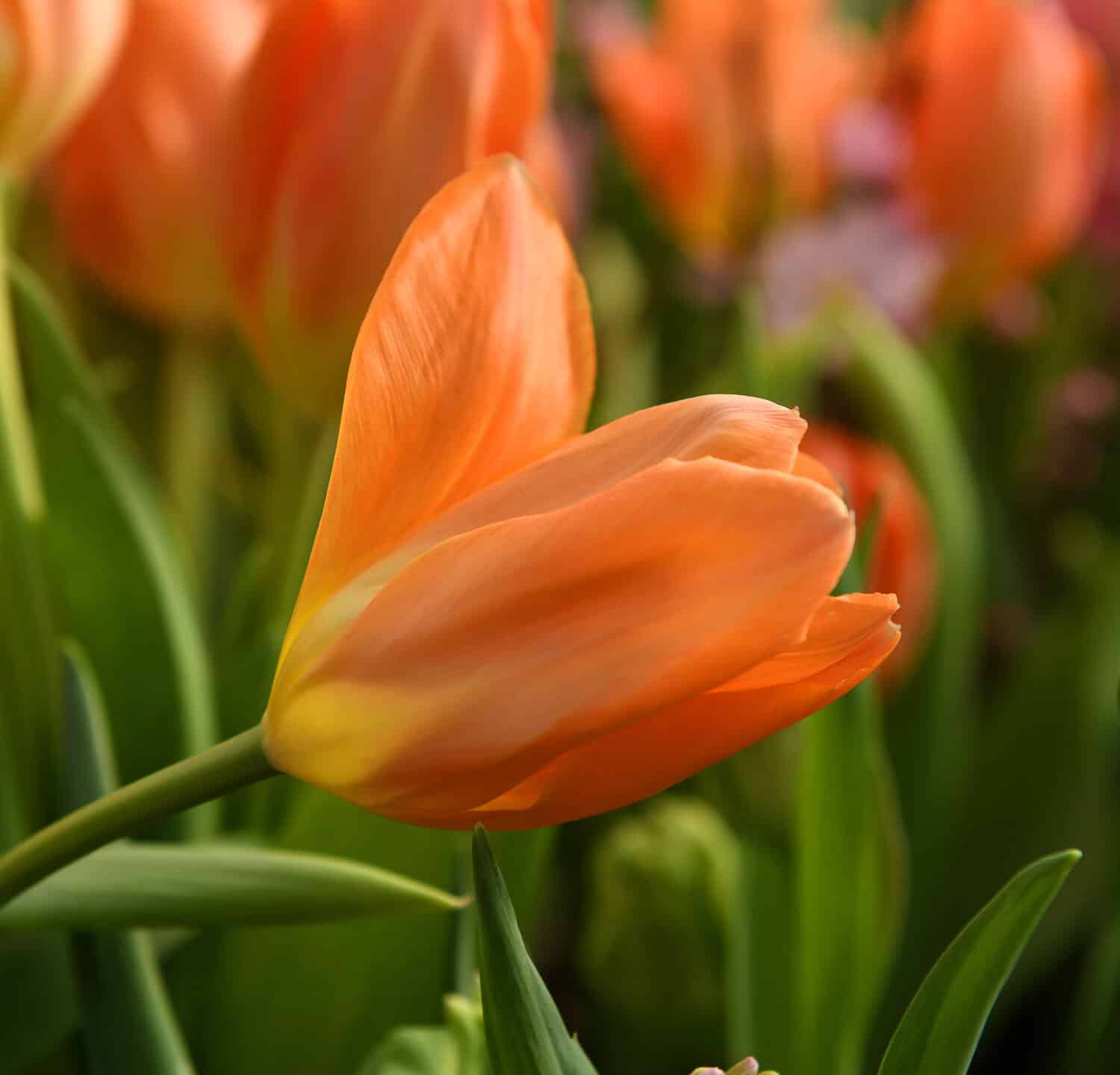
The Orange Brilliant blooms get as wide as 10 inches in full bloom.
©Popova Valeriya/Shutterstock.com
Botanical Name: Tulipa fosteriana ‘Orange Brilliant’
Tulipa fosteriana ‘Orange Brilliant’ is a stunning tulip that will catch the eye with its vibrant and bold appearance. The blooms of this tulip are large and perfectly shaped, with petals that are bright shades of light to deep orange.
Orange Brilliant grows up to 18 inches tall with incredible blooms fanning out as wide as 10 inches during the peak season. Plant this beauty in USDA zones 3-7 with full sunlight and well-draining soil for best results.
Thank you for reading! Have some feedback for us? Contact the AZ Animals editorial team.

